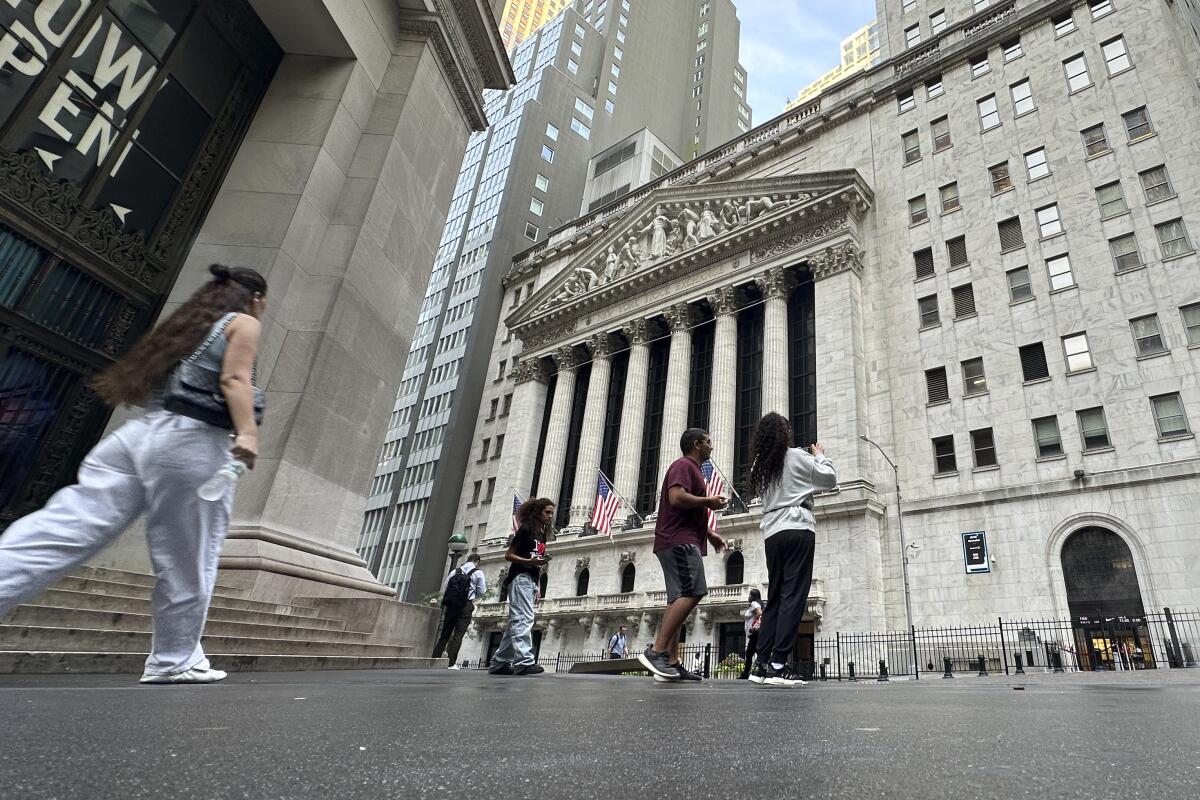Wall Street rises to the edge of records as its momentum keeps rolling

- Share via
NEW YORK — U.S. stocks ticked to the edge of records Monday as Wall Street’s momentum keeps driving it upward.
The Standard & Poor’s 500 index rose 15.87 points, or 0.3%, to 5,631.22 and finished just shy of its all-time high set last week. It’s coming off its 10th winning week in the last 12, lifted in large part by expectations that inflation is slowing enough to convince the Federal Reserve to ease interest rates soon.
The Dow Jones industrial average climbed 210.82 points, or 0.5%, to 40,211.72 and set its own record, while the Nasdaq composite added 74.12 points, or 0.4%, to 18,472.57 and ended a bit short of its high.
Some of the market’s best-performing areas were ones that do best when former President Trump’s chances for election look better. Trump Media & Technology Group, the company behind Trump’s Truth Social platform, leaped 31.4%. Bitcoin rose back above $63,000 after Trump, who has painted himself as a crypto-friendly candidate, survived an assassination attempt over the weekend.
Yields for longer-term Treasurys also pushed higher than shorter-term ones, and the 10-year Treasury yield climbed to 4.22% from 4.19% late Friday. Something similar happened after last month’s debate between Trump and President Biden, when traders made moves in anticipation of a Republican sweep in November that could ultimately mean policies that would raise the U.S. government’s debt.
Stocks of big financial companies, which could benefit from a lighter regulatory touch from a Republican administration, also helped lead the market. JPMorgan Chase climbed 2.5% and was one of the strongest forces pushing the S&P 500 higher.
Investment bank Goldman Sachs rose 2.6% after reporting stronger profit and revenue for the latest quarter than analysts expected. BlackRock, the asset manager behind the iShares exchange-traded funds, slipped 0.6% after topping forecasts for profit but coming up a bit shy for revenue.
Expectations are high coming into this earnings reporting season, which unofficially got underway last week. Analysts are forecasting companies in the S&P 500 will deliver overall growth of 9.3% from a year earlier, according to FactSet. That would be the strongest growth in more than two years.
Such forecasts have been one of the forces pushing U.S. stocks toward records. So have encouraging reports on inflation, which have shown enough of a slowdown for much of Wall Street to expect the Federal Reserve to begin cutting its main interest rate in September.
For roughly a year, the Fed has been keeping its main interest rate at the highest level in more than two decades. Lower rates would release pressure that’s built up on the economy because of how expensive it’s become to borrow money to buy houses, cars or anything on credit cards. Fed officials, though, have been saying they want to see “more good data” on inflation before making a move.
In remarks before the Economic Club of Washington, Federal Reserve Chair Jerome H. Powell said again Monday that he won’t send any signals about when the Fed may cut interest rates. But he also said Fed officials understand the risks of waiting both too long and not long enough. Too-late cuts could push the U.S. economy into a recession, while too-aggressive cuts could allow inflation to reaccelerate.
Despite the seemingly unstoppable run for the U.S. stock market, some skeptics are sticking with their caution amid what they see as too-expensive prices. The S&P 500 has already leaped 18% and set an all-time high 37 times this year.
Barry Bannister, chief equity strategist at Stifel, acknowledged he was at least early in his call this year for an imminent “correction” in stock prices, but he is still warning about the possibility for an upcoming drop of 10%.
He said high inflation could remain stubborn, and he’s looking for the U.S. economy’s growth to be slower than expected in the second half of the year. Such a mix constitutes “moderate stagflation” and could particularly hurt the high-growth stocks that have been leading Wall Street, according to Bannister.
Among individual companies, U.S.-listed shares of Burberry skidded 16.1% after the British luxury fashion house said it has appointed Joshua Schulman, formerly head of Michael Kors and Coach, as its new chief executive. The unexpected announcement came as Burberry said its first-quarter revenue was down 21%, and it suspended its dividend.
Macy’s tumbled 11.7% after it ended talks for a potential buyout by two investment firms that had lasted months. The retailer said the firms’ latest offer wasn’t high enough to be compelling and also may not have been fully financed.
In stock markets abroad, Chinese indexes were mixed after China reported its economy expanded at a slower-than-expected pace in the latest quarter and as its ruling Communist Party opened a once-a-decade policy-setting meeting. Hong Kong’s Hang Seng fell 1.5%, while stocks in Shanghai added 0.1%.
Stock indexes were mostly lower in Europe.
Choe writes for the Associated Press
More to Read
Inside the business of entertainment
The Wide Shot brings you news, analysis and insights on everything from streaming wars to production — and what it all means for the future.
You may occasionally receive promotional content from the Los Angeles Times.










